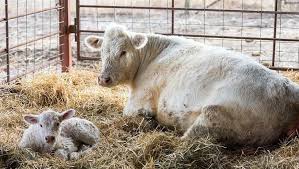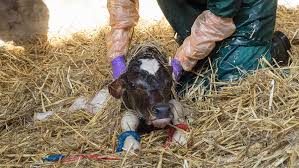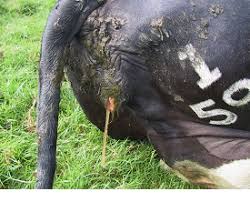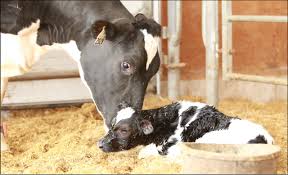Calving is a crucial phase in the life cycle of dairy and beef cattle, marking the arrival of a new calf and the beginning of the cow’s lactation period. Proper calving care is essential to ensure the health and well-being of both the cow and the calf, as well as to promote a successful transition into milking or breeding.
This complete guide will provide comprehensive insights into the best practices for calving care, covering everything from preparation and monitoring to post-calving management.
Understanding the signs of impending calving is the first step in providing effective care. As the due date approaches, cows exhibit several physical changes and behaviors, such as an enlarged udder, swelling of the vulva, and increased restlessness.
Recognizing these signs allows farmers to prepare adequately, ensuring that they are present to assist during the calving process. Having a clean, quiet, and comfortable calving area is vital, as it helps reduce stress for both the cow and the calf.
During calving, there are key steps to ensure the safety and health of the animals involved. It’s essential to monitor the progress of labor and be prepared to assist if complications arise.
This may include using calving chains or ropes to help guide the calf into the correct position for delivery. Additionally, knowing when to call for veterinary assistance can be crucial in preventing potential issues that may arise during the calving process.
After the calf is born, immediate care is vital to ensure its health and vitality. The first few moments after birth are critical, as the calf needs to stand and nurse within the first few hours of life to receive colostrum, which is rich in antibodies and nutrients.
Proper colostrum management is essential, as it provides the newborn calf with the necessary immune protection and energy to thrive.
Monitoring the calf’s behavior, appetite, and overall health in the days following birth is crucial, as early detection of any health issues can make a significant difference in the calf’s long-term development.
Post-calving care for the cow is equally important. Cows require proper nutrition and monitoring to ensure they recover from the physical demands of calving and begin producing milk efficiently.
Providing high-quality feed, clean water, and a stress-free environment helps support the cow’s recovery and overall health. Keeping an eye on the cow for signs of complications, such as retained placenta or mastitis, is essential for maintaining her health and productivity.
Understanding the Calving Process

Calving involves several stages, including labor, delivery, and the immediate care of the newborn calf. During this time, both the cow and calf require attention and care to ensure their health and well-being.
1. Gestation Period: The typical gestation period for cattle is around 283 days, although it can range from 279 to 287 days. Proper monitoring during this time is crucial for anticipating the calving process.
2. Stages of Labor:
Stage One: This stage can last several hours or even days. The cow may become restless, isolate herself, and show signs of discomfort. She may also exhibit nesting behavior, such as pawing at the ground.
Stage Two: This stage involves the actual delivery of the calf. It usually lasts between 30 minutes to two hours. The cow will strain, and you may see the amniotic sac or hooves appearing.
Stage Three: This stage involves the expulsion of the placenta, which usually occurs within 6 to 12 hours after calving. Proper disposal of the placenta is important to prevent disease.
Signs of Upcoming Calving
Recognizing the signs of impending calving is essential for timely intervention if needed. Here are some key indicators to watch for:
1. Swollen Vulva: As the cow approaches calving, her vulva may become swollen and loose. This is one of the first signs indicating that calving is near.
2. Nesting Behavior: Cows often exhibit nesting behavior, such as pawing at the ground or arranging bedding in their calving area. This behavior usually increases as calving time approaches.
3. Restlessness: The cow may become agitated and restless, moving around more than usual. She may also separate herself from the herd as she prepares for calving.
4. Changes in Appetite: Some cows may lose interest in feed or water as they approach calving. This can be a sign that labor is imminent.
5. Milk Changes: As calving approaches, the cow’s udder may become fuller, and colostrum (the first milk) may start to leak. This is an important sign that calving is near.
Preparing the Calving Area
Proper preparation of the calving area is essential for ensuring a safe and hygienic environment for both the cow and the calf. Follow these steps to prepare:
1. Choose a Clean, Dry Location: Select a calving area that is clean, dry, and well-drained to minimize the risk of infections. Avoid areas with muddy or wet conditions.
2. Provide Adequate Space: Ensure there is enough space for the cow to move around comfortably. A 12×12 foot area is generally sufficient for the cow to give birth without obstacles.
3. Bedding: Use clean straw or dry bedding to provide comfort and insulation for the cow. This also helps absorb moisture and keeps the environment dry.
4. Equipment and Supplies: Gather necessary supplies such as clean towels for drying the calf, a calf puller in case assistance is needed during delivery, disinfectant for cleaning any surfaces or equipment, and colostrum or milk replacer for the calf, in case the cow cannot nurse immediately.
5. Monitor the Area: Keep an eye on the calving area for signs of distress or complications. Be prepared to assist the cow if necessary and ensure a calm environment.
Essential Tools and Supplies
Having the right tools and supplies on hand is vital for ensuring a successful calving process. Here’s a list of essential items you should prepare:
1. Clean Towels: Used for drying the newborn calf after birth to stimulate circulation and keep it warm.
2. Calf Puller: A tool for assisting in the delivery if the calf is in a difficult position. This should be used carefully to avoid injury to the cow or calf.
3. Disinfectant: For cleaning surfaces and tools to prevent infection. Maintaining a sterile environment is crucial for the health of the cow and calf.
4. Colostrum or Milk Replacer: Essential for feeding the newborn calf if the mother cannot nurse immediately. Colostrum provides vital nutrients and antibodies for the calf’s immune system.
5. Mineral and Electrolyte Solutions: These can be used to help hydrate the cow post-calving and replenish lost nutrients.
6. Calving Kit: A comprehensive kit containing gloves, lubricant, and other items needed during the calving process.
Read Also: Nitrogen Gains and Losses in Soil-Plant System
Assisting with the Calving Process

In some cases, you may need to assist the cow during calving. Here are steps to take if intervention is necessary:
1. Assess the Situation: Before intervening, observe the cow to determine if she needs help. If the cow is in distress and there is no progress after 30 minutes of active labor, assistance may be needed.
2. Wear Clean Gloves: Always wear clean, disposable gloves when assisting to prevent introducing bacteria into the birth canal.
3. Use Lubricant: Apply a sterile lubricant to facilitate easier delivery if you need to assist with the calf’s presentation.
4. Positioning the Calf: If the calf is in an abnormal position (e.g., backward or sideways), gently guide it back into the correct position. This may involve rotating the calf or pulling gently on the legs.
5. Pulling the Calf: If necessary, apply gentle, steady pressure when the cow is pushing. Never pull too hard, as this can harm both the cow and the calf.
6. Monitor the Cow: After delivery, continue to monitor the cow for any signs of complications, such as excessive bleeding or distress.
Post-Calving Care for the Cow
After calving, the cow requires specific care to recover and maintain her health. Follow these steps:
1. Check for Complications: Ensure the cow has expelled the placenta and check for any signs of retained placenta, which may require veterinary attention.
2. Provide Fresh Water and Feed: Offer the cow access to clean water and high-quality feed to help her regain strength and promote milk production.
3. Monitor Vital Signs: Keep an eye on the cow’s vital signs, including temperature, heart rate, and respiration. A temperature above 102.5°F may indicate an infection.
4. Observe for Milk Production: Ensure the cow is beginning to produce milk. This is crucial for the calf’s health, as it needs colostrum within the first few hours of life.
5. Keep the Environment Clean: Maintain a clean and dry environment to prevent infections and promote recovery.
Care for Newborn Calves
Newborn calves need special attention right after birth to ensure they are healthy and thriving. Here’s how to care for them:
1. Dry the Calf: Use clean towels to dry the calf thoroughly, especially around the face and belly. This helps to stimulate circulation and maintain body temperature.
2. Ensure Colostrum Intake: The calf should nurse from the mother within 1 to 2 hours after birth. If the mother is unable or unwilling to nurse, provide colostrum or a milk replacer.
3. Monitor for Weakness: Watch for signs of weakness or lethargy in the calf. A healthy calf should be standing and nursing shortly after birth.
4. Vaccination and Health Check: Schedule a health check with a veterinarian to discuss vaccinations and deworming to prevent disease in the calf.
5. Provide Shelter: Ensure the calf is kept in a clean, sheltered area protected from harsh weather. This will help maintain warmth and prevent stress.
6. Socialization: Introduce the calf to other animals gradually, as social interaction is important for its development.
Read Also: The Type of Bird Recommended for Low Capital start up and the Quantity to Start with
Common Calving Complications

Calving can sometimes lead to complications that require prompt attention. Here’s a list of common issues you might encounter:
1. Dystocia: This is a difficult or prolonged labor due to the calf’s size, positioning, or other factors. Intervention may be necessary if the cow is unable to deliver after an extended period.
2. Retained Placenta: When the placenta does not expel after calving, it can lead to infections and complications. Veterinary assistance may be needed to resolve this issue.
3. Uterine Prolapse: This occurs when the uterus slips out of place, usually after calving. It requires immediate veterinary care to reposition and treat the uterus.
4. Milk Fever (Hypocalcemia): A condition caused by low calcium levels in the cow’s blood, leading to weakness and potential collapse. Early signs include trembling or muscle stiffness. Treatment involves calcium supplementation.
5. Metritis: An infection of the uterus that can occur after calving, often characterized by a foul-smelling discharge. Treatment typically includes antibiotics.
6. Mastitis: Inflammation of the udder, which can occur during lactation. It can be caused by bacteria and requires veterinary treatment to ensure the cow’s milk is safe.
Nutrition for Pregnant and Nursing Cows
Proper nutrition during pregnancy and nursing is vital for the health of both the cow and her calf. Here’s what to focus on:
1. Energy Requirements: Pregnant and nursing cows have higher energy needs. Provide high-quality forage and concentrates to meet these requirements.
2. Protein Intake: Ensure the diet includes adequate protein to support fetal development and milk production. Good sources include soybean meal and alfalfa.
3. Vitamins and Minerals: Supply essential vitamins (A, D, E) and minerals (calcium, phosphorus) to support the cow’s health and the development of the calf. Mineral supplements can be beneficial.
4. Adequate Water Supply: Fresh, clean water is crucial for maintaining hydration, especially during lactation. Cows should have constant access to water.
5. Avoiding Overfeeding: Monitor body condition to avoid overfeeding, which can lead to obesity and complications during calving.
6. Transition Diets: Implement a transition diet a few weeks before calving to prepare the cow for increased nutrient demands during lactation.
Record Keeping and Monitoring
Effective record keeping and monitoring are essential for successful cow management, especially around calving. Here are key practices to adopt:
1. Calving Records: Maintain detailed records of each cow’s calving date, calf gender, birth weight, and any complications. This information aids in future planning and management.
2. Health Monitoring: Track vaccinations, health checks, and any treatments administered to ensure the health of both the cow and calf.
3. Nutrition Logs: Keep track of feed intake, diet changes, and any supplements given. This helps assess nutritional needs and monitor the cow’s condition.
4. Performance Metrics: Record milk production levels, growth rates of calves, and any behavioral observations to identify trends and areas for improvement.
5. Use of Technology: Consider utilizing farm management software or apps to streamline record keeping and data analysis, making it easier to monitor herd health and performance.
6. Review and Adjust Plans: Regularly review records to adjust management practices, ensuring optimal health and productivity for the herd.
Do you have any questions, suggestions, or contributions? If so, please feel free to use the comment box below to share your thoughts. We also encourage you to kindly share this information with others who might benefit from it. Since we can’t reach everyone at once, we truly appreciate your help in spreading the word. Thank you so much for your support and for sharing!
Read Also: What is some advantages of solar energy?






